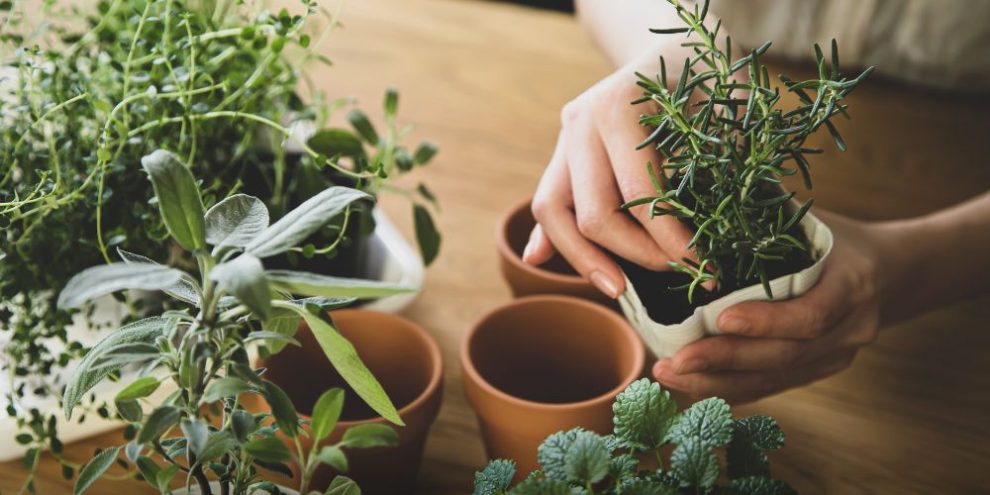
Craving the taste of fresh herbs but tired of expensive supermarket bundles? Growing your own herbs at home is a surprisingly easy and rewarding way to add fresh flavor to your meals.
Not that great at gardening? There are plenty of herbs that thrive with minimal care, perfect for beginner home gardeners.
Today, we'll take a look at some of the easiest herbs to cultivate and enjoy in your own kitchen. But first, let’s talk about whether you should plant them inside or out.
Barrie's News Delivered To Your Inbox
By submitting this form, you are consenting to receive marketing emails from: Central Ontario Broadcasting, 431 Huronia Rd, Barrie, Ontario, CA, https://www.cobroadcasting.com. You can revoke your consent to receive emails at any time by using the SafeUnsubscribe® link, found at the bottom of every email. Emails are serviced by Constant Contact
Inside or outside? Choosing the perfect home for your herbs
While most herbs thrive outdoors in a sunny spot with well-drained soil, some varieties do just fine indoors on a bright windowsill. Here's a quick guide to help you decide where to grow your herbs:
Herbs that are better off outdoors
Outdoor gardens offer more variety and tend to produce a higher yield than indoor plants. If you have access to a sunny patio or garden space then these are some of the herbs you should consider growing outside.
- Basil: This sun-loving favorite thrives in warm weather and reaches its full flavor potential outdoors.
- Oregano: This perennial herb prefers the warmth and air circulation of an outdoor space, rewarding you with fragrant leaves perfect for Italian dishes.
- Rosemary: Woody and fragrant, rosemary loves hot and dry conditions, making it ideal for outdoor gardens in the summer months.
- Sage: Another sun-worshipper, sage produces a bounty of silvery-green leaves best suited for outdoor growing.
- Thyme: While thyme can adapt to some indoor conditions, it truly flourishes outdoors, especially in drier climates with well-drained soil.
- Cilantro: This fast-growing herb prefers cooler temperatures. Enjoy its refreshing flavor by planting outdoors in spring or fall.
- Dill: This tall and feathery herb thrives in cooler weather and benefits from the extra space an outdoor garden provides.
Herbs that can be grown indoors
Indoor gardens are ideal for year-round enjoyment of fresh herbs. Here are some herbs that usually to do well indoors (just make sure they have a sunny windowsill and proper drainage):
- Mint: Mint's vigorous growth habit makes it a perfect indoor herb. (If you do grow it outdoors, keep it in a pot to prevent it from taking over.)
- Parsley: This versatile herb tolerates a wider range of light conditions, making it adaptable to most indoor spaces.
- Chives: Easy to grow and quick to regrow after harvesting, chives add a mild onion flavor to your dishes and thrive on a sunny windowsill.
- Thyme: While thyme can also do well outdoors, it adapts well to pots and sunny indoor locations.
- Bay Laurel: This slow-growing but rewarding herb can be grown in a large pot indoors, providing fragrant leaves for soups and stews.
- Lemon Balm: This easy-care herb adds a refreshing citrusy flavor to teas and cocktails and thrives in a sunny indoor spot.
Remember, these are just general recommendations. Always check the specific needs of each herb variety you choose to ensure it thrives in your chosen environment.
Tips for growing herbs inside
Growing fresh herbs inside is a delightful way to brighten your home (and add delicious convenience to your cooking!) But indoor herb gardens require a bit more TLC compared to their outdoor counterparts.
Here are some key tips for cultivating a thriving indoor herb oasis:
- Light is life: Most herbs crave sunshine! Find a location that receives at least 6 hours of bright, indirect sunlight daily. South-facing windows are ideal, but east or west can work with some herb varieties . If natural light is limited, consider supplementing with grow lights for 12-14 hours a day.
- The perfect pot: Choose pots with drainage holes to prevent waterlogging, which can lead to root rot. Terracotta pots breathe well, while plastic pots retain moisture. Select pots appropriate for the herb's mature size; too small and your herbs will struggle to thrive.
- The watering balancing act: Unlike their outdoor brethren, indoor herbs dry out faster due to less air circulation and controlled humidity. Water thoroughly when the top inch of soil feels dry to the touch, but avoid leaving them soggy. Empty the drainage tray after watering.
- Fertile ground: Use a well-draining potting mix specifically designed for herbs or vegetables. Most herbs don't require frequent feeding, but a gentle, balanced fertilizer solution every few weeks during the growing season can be beneficial.
- Location, location, location: Keep your herbs away from heat sources like vents and radiators, and avoid drafty windows. Aim for a room temperature between 65-75°F (18-24°C).
- Snip, sip, and repeat: Regularly harvest your herbs to encourage bushier growth. Pinch off leaves just above a leaf node (fancy wording for where the lead stem meets the main stem). Avoid pinching off more than a third of the plant's growth at once. The more you harvest, the more your herbs will produce!
- Rotate for growth: Indoor plants naturally lean towards the light source. Regularly rotate your pots a quarter turn every week to ensure even growth on all sides.
- Fresh air is essential: Provide good air circulation whenever possible. Open windows on mild days or gently circulate air with a fan (avoid directly blasting the herbs).
By following these tips and choosing the right herbs for your indoor environment, you'll be well on your way to enjoying a constant supply of fresh flavor at your fingertips all year round.
Tips for growing herbs indoors
There's nothing quite like snipping fresh herbs straight from your garden to add a burst of flavor to your meals. But unlike their pampered indoor cousins, outdoor herbs require a slightly different approach.
Here are some key tips to cultivate a flourishing outdoor herb garden:
- There’s different types of sunlight: Most herbs are sun-worshippers, thriving in at least 6-8 hours of direct sunlight daily. When choosing a location, consider the amount of sunlight different areas of your garden receive throughout the day. For instance, some herbs might struggle with the harsh afternoon sun, so putting them where they get morning sun but afternoon shade may be better.
- Location, location, location: Go beyond just sunlight! Herbs generally prefer some shelter from strong winds, especially tall varieties. You also want to consider drainage, which leads us to our next tip …
- Soil matters: Raised garden beds can be a great option for creating optimal drainage for herbs, especially in areas with heavy clay soil. Amend your soil with compost or aged manure to improve drainage and provide essential nutrients. While most herbs don't need constant feeding, a light application of a balanced fertilizer in early spring can give them a good start.
- Plan your planting: Space your herbs according to their mature size. Herbs like basil and oregano can grow quite bushy, while thyme tends to be more compact. Similarly, you will want to be sure that tall herbs, like dill, are blocking the sun from getting to shorter varieties. Check the spacing recommendations on the plant label or seed packet to avoid overcrowding and ensure optimal sun exposure.
- Watering wisdom: Mother Nature might provide most of the hydration, but keep an eye on your herbs, especially during hot, dry periods. Water deeply when the top inch of soil feels dry to the touch, allowing the water to penetrate the root zone. Avoid frequent shallow watering, which encourages shallow root growth.
- Mulch is magic: Apply a layer of organic mulch around your herbs to retain moisture, suppress weeds, and regulate soil temperature. Aim for a 2-3 inch layer of mulch, keeping it away from the base of the plant stems to prevent rot.
- Snip and savor: Regularly harvest your herbs throughout the growing season to encourage bushier growth and prevent flowering, which can affect flavor. As you do with indoor herbs, pinch off leaves just above a leaf node, avoiding taking more than a third of the plant's growth at once.
- Winter woes: Not all herbs are created equal when it comes to winter. Tender varieties like basil won't survive a frost, so enjoy them throughout the growing season then replant next year. Hardier herbs like rosemary, sage, and thyme can often withstand colder temperatures. Simply protect them with a layer of mulch in fall and they should sprout back up in the new year.
9 easy herbs to grow at home
Now that you're armed with the knowledge of growing herbs inside your home and out, let's explore some fantastic options that are perfect for beginners. Here are 9 easy-to-grow herbs for you to try:
1. Basil: The king of fresh herbs
Basil is an absolute superstar in the herb garden. This fragrant favorite boasts a sweet, peppery flavor with a hint of anise.
Genovese basil, the most common variety, thrives in warm weather and prefers sun-drenched locations like a south-facing balcony. Pinch off flower buds to encourage leaf growth and enjoy its unmistakable licorice notes in Caprese salads, pesto, or fresh summer tomato dishes.
Fun fact: The spicy aroma of basil is also said to repel flies!
2. Chives: The herb that keeps on giving
Don't be fooled by their delicate appearance – chives pack a mild onion punch with a subtle hint of garlic.
Not only are the chive blades delicious snipped over omelets, baked potatoes, or creamy soups, but the beautiful purple flowers are edible too! Sprinkle them on salads for a burst of color and a delicate garlicky kick.
3. Parsley: The versatile workhorse
Parsley is a must-have for any herb garden. Both curly-leaf and flat-leaf varieties are easy to grow and add a vibrant pop of color to any dish.
Parsley is also a natural breath freshener, so munch on a sprig after a strong-flavored meal.
Fun fact: In ancient Greece, parsley was a symbol of victory, often worn by athletes during the Olympic Games.
4. Mint: The refreshing invader
The unmistakable refreshing coolness of mint makes it a summertime favorite.
Its refreshing flavor makes it a perfect choice for teas, cocktails (mojitos anyone?), and even desserts.
Experiment with different varieties like chocolate mint or apple mint for exciting flavor twists in desserts and cocktails.
But remember, mint is a prolific grower, so start with a small pot to keep it contained.
5. Thyme: The Titan of flavour
Don't let its small size fool you – thyme packs a powerful punch of flavor with its warm, peppery profile and a hint of lemon.
With over 300 varieties boasting subtle flavor variations, thyme offers endless culinary adventures. Try lemon thyme for a citrusy twist in fish dishes or pair English thyme with roasted chicken for a classic flavor combination.
Fun fact: Thyme was once used as a symbol of courage in ancient Egypt.
6. Oregano: The Italian essential
Oregano is a cornerstone of Italian cuisine. But its strong, herbaceous flavor with a hint of peppery spice adds depth to a wide range of dishes.
While it's a natural fit for pizzas and pasta sauces, it can be unexpected and delicious in many other classics. Feeling adventurous? Oregano's earthy notes can even complement sweet treats like dark chocolate chip cookies for a complex flavor profile.
Harvest oregano leaves before the plant flowers for the best flavor.
7. Rosemary: The woody wonder
Rosemary's woody fragrance and piney flavor with a touch of peppery spice elevate countless dishes.
While it's a classic companion to roasted chicken and potatoes, rosemary can do so much more! Steep fresh sprigs in olive oil for an herb-infused oil perfect for dipping bread or drizzling over grilled vegetables.
Fun fact: Rosemary was once believed to improve memory and concentration.
8. Cilantro: The herb you either love or hate
Cilantro's unique flavor profile is a divisive one. Some adore its bright, citrusy notes with a hint of soapiness, while others find it overpowering.
Genetics play a role in this – if you find cilantro soapy, try varieties like 'Santo' or 'Cilantro Lime' known for their milder flavor.
Cilantro is a key ingredient in guacamole, salsas, and many Asian dishes. But remember, it’s best to enjoy cilantro fresh, as its flavor deteriorates quickly after harvesting.
Fun fact: Cilantro and coriander seeds come from the same plant! Cilantro is just the leaves of coriander.
9. Sage: The silvery sensation
Sage leaves were once used as a natural silver polish, and the herb's name comes from the Latin word "salvere" which means "to heal" – a testament to its historical medicinal uses.
Sage's silvery-green leaves boast a complex earthy flavor with subtle hints of pepper and mint. This aromatic herb pairs beautifully with poultry dishes, adding depth to stuffing and gravies. Its earthy notes also complement creamy sauces and winter squashes.
So there you have it! With a little sunshine, some basic care, and these easy herbs, you can be enjoying fresh, flavorful additions to your meals in no time. Happy planting!











